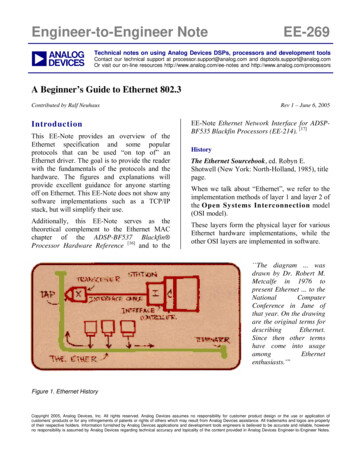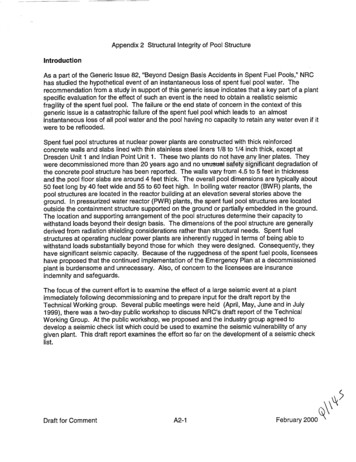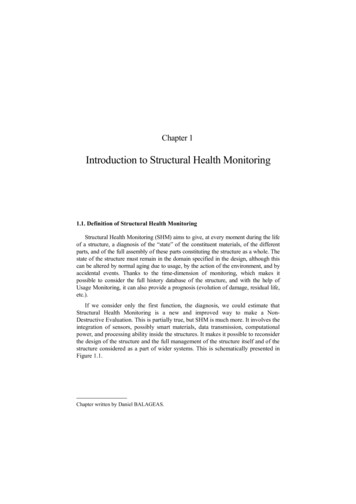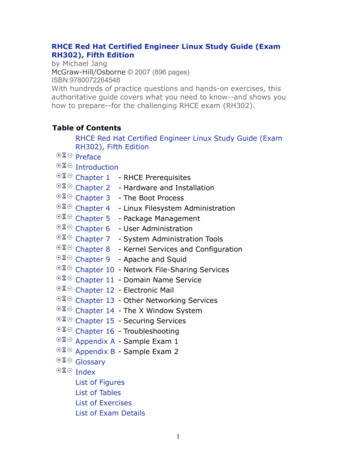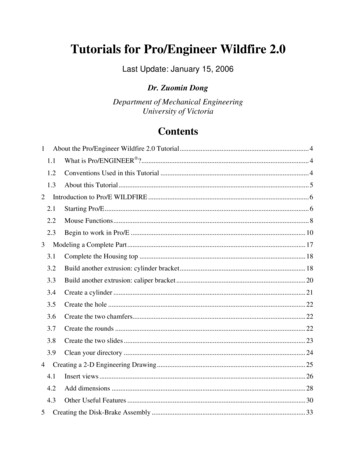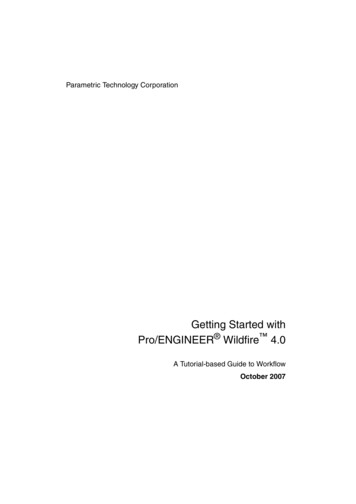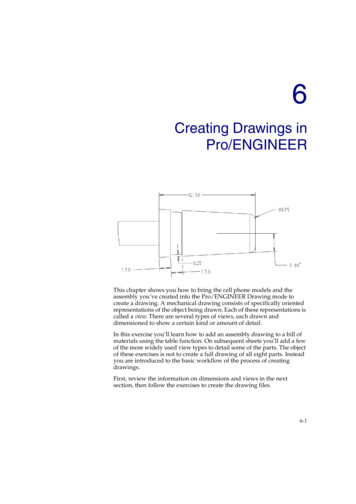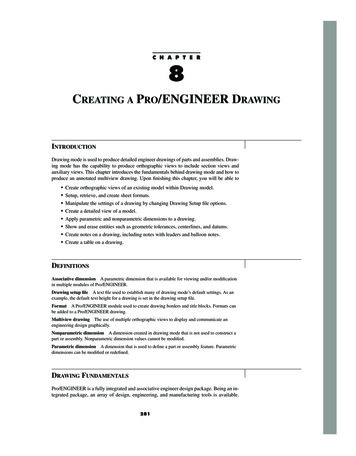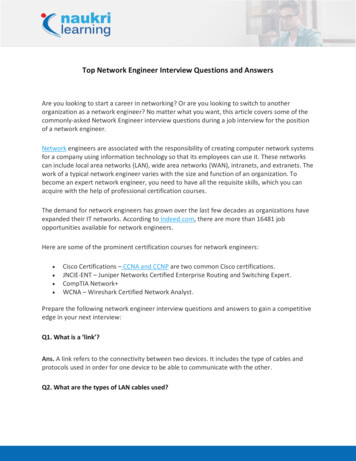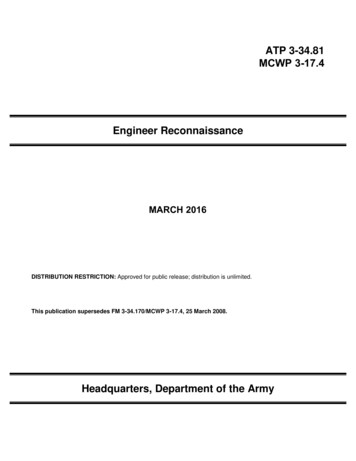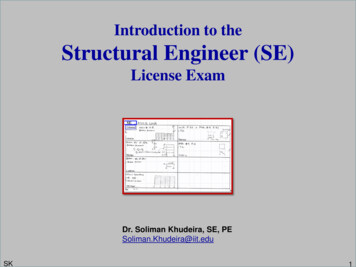
Transcription
Introduction to theStructural Engineer (SE)License ExamSEDr. Soliman Khudeira, SE, PESoliman.Khudeira@iit.eduSK1
Importance of Licensing License distinguishes you among othercandidates / peers Owning a firm (consulting) Only a Licensed Engineer can sign/seal designs Prestigious Shows commitment to the engineering profession You will earn more than peers with a SE U.S. News & World Report: “[Engineering]licensure is crucial for career advancement andtop pay.”SK2
Importance of LicensingYour degree, work references, andtechnical skills are not necessarily anobjective way to assess the engineer’scompetence. However, the SE License isa universal standard that is recognizedthroughout the professionSK3
Steps to be a LicensedStructural Engineer (SE)1. Pass the FE exam, then you are an EIT (or EI)2. Graduate from EAC/ABET-accredited college3. Have 4 years of structural engineering experience(must be under the supervision of a licensed SE)4. Pass the SE I (8 hours exam)5. Pass the SE II (8 ours exam)Then you are a Licensed Structural Engineer (SE)SK4
SKFE / EIT5
FE Exam- Computer Based Testing (CBT)Seven free-standing, discipline-specific exams:1. Chemical2. Civil3. Electrical and computer4. Environmental5. Industrial6. Mechanical, and7. Other disciplinesEach exam covers materials commonly found in thatdiscipline's curriculumSK6
SKSE7
The Concept of “Most Nearly” Many problems in the exam ask for the option thatis “most nearly correct.” An answer that exactly matches your calculationsis not always given. The phrase “most nearly” is used to accommodatesolutions that have been derived correctly but thatmay be slightly different from the option given on theexam. Use good engineering judgment when selectingyour option.SK8
The Concept of “Most Nearly”Examples:1. If the problem asks you to determine the load on abeam, then select the option that is most nearly whatyou calculated, regardless of whether it is more orless than your calculated value.2. If the problem asks you to find the size of a beam tocarry a specified load, then select the option that willsafely carry the load. In this case, select the optionthat is equal to or larger than the beam size youcalculated. In other words, do not select a beamsize that is smaller than the size you calculatedSK9
SKThe Concept of “most nearly”Question:Solution:What is most nearly thereaction at “B”A) 1.5 kNB) 2.3 kNC) 2.6 kND) 2.9 kN1Lh 3.5 kN2F2 Lh 3 kNF1 Sum of moments at A MA 0Therefore :R B 2.66 kNAnswer is C), not D)10
Selection of “most nearly” OptionQuestion:The tip deflection (inches) of thebeam shown below is most nearly:A) 1.45.B) 1.98C) 2.25D) 2.85Solution:wL4 8EI3K in 4 2.5 (12 ft)) 12 ft ft K (3)(9) 3 4 8 29,000in 2 in 12 W 2.50 kips/ftE 29,000 ksiI 182.25 in4 2.10 inches12 ft9 in.3 in.SKAnswer is C), not B)BEAM CROSSSECTION11
Selection of “most nearly” OptionQuestion:The cross sectional dimensions of thebeam shown below ( to safely supportthe applied load) is most nearly:A) 9 in. x 5 in.B) 9 in. x 4 in.C) 9 in. x 6 in.D) 9 in. x 3 in.W 0.50 kips/ftE 29,000 ksiI 182.25 in412 ftbSolution:If you calculate the cross sectionaldimensions of the beam to be:9 in. x 3.3 in., then you shouldselect option “B”, not “D”Notes: Option “D” is 9 in. x 3 in.,which is less than what youcalculated. Therefore, thedimensions of the selected beamhas to be more than or equal to 9in. x 3.3 in. The only answer thatsatisfy this condition is “B”hAnswer is B, not DSKBEAM CROSSSECTION12
Selection of “most nearly” OptionQuestion:A 150 pcf concrete gravityretaining wall is shown.The safety factor againstoverturning is most nearly:A) 3.4B) 3.8C) 2.2D) 1.71 ft. 105 pcf 30 H 10 ft.c 0Solution:Resisting Moment (1' )(10' )(150)(5.5' ) Ovedrturning Moment : 30Ka tan 2 (45 ) tan 2 (45 ) 0.3322( K a H ).H 0.33x105 x10 2Pa 1,733 Ib.22H10Overturning Moment Pa ( ) 1,733( ) 5,775 ft lb.33PaOverturning F.S. B 6 ftSK(5' )(10' )2x(150)( x5' ) 20,750 ft - Ib.23Ka . .HResistingM oment20,750 3.60OverturningMoment 5,775Answer is A, not B13
SE - Exam ScheduleYearPE, PS,SE VerticalSE Lateral2017Apr 21, Oct 27Apr 22, Oct 282018Apr 13, Oct 26Apr 14, Oct 272019Apr 5, Oct 25Apr 6, Oct 262020Apr 17, Oct 23Apr 18, Oct 242021Apr 23, Oct 22Apr 24, Oct 232022Apr 22, Oct 21Apr 23, Oct 222023Apr 14, Oct 27Apr 15, Oct 2820242025Apr 12, Oct 25Apr 13, Oct 26Apr 11, Oct 24Apr 12, Oct 25Check NCEES website for updated datesSK14
Allowed Reference Materials in the Exam The SE exam is open book. Candidates maybring printed reference materials, as long as theyare bound and remain bound during the exam. Loose paper may be bound with ring binders,plastic snap binders, spiral-bound notebooks,and screw posts, but not with staples. Sticky notes and flags are permitted only whenthey remain attached to book pages.SK15
Reference Materials in the ExamSK16
SKSE17
SE Exam 16-hours (in addition to passing the FE) The exam uses separate vertical and lateral components: Friday Component – 8 hour Vertical Forces:gravity loads and lateral earth pressures Saturday Component – 8 hour Lateral Forces:Wind/Earthquake Breadth modules are in the morning sessions: containquestions from all structural engineering topics. Allquestions are multiple-choice Depth modules are in the afternoon sessions: you willchoose either buildings or bridges. You must work thesame topic area on both components. All questions areconstructed response (essay)SK18
SE Exam You are not required to obtain acceptableresults on both 8-hour components in a singleexam administration. You can sit for andobtain acceptable results on one component,and then sit for and obtain acceptable resultson the second component at a later date. You must obtain acceptable results on both8 hour components within five year period inorder to pass the SE exam.SK19
SE Pass Rate(for the April 2016 exam)SK20
SE Design Standards:CheckNCEESwebsite forupdated listSK21
SE Design Standards:CheckNCEESwebsite forupdated listSK22
SE Design Standards:CheckNCEESwebsite forupdated listSK23
SE Design Standards:CheckNCEESwebsite forupdated listSK24
Calculators AllowedThe only calculator models acceptable for use during the exam are:Casio: All fx-115 models. Any Casio calculator must contain fx-115 in itsmodel name. Examples of acceptable Casio fx-115 models include (butare not limited to) fx-115 MS fx-115 MS Plus fx-115 MS SR fx-115 ESCheckNCEESwebsite forupdated listSKHewlett Packard: The HP 33s and HP 35s models, but no others.Texas Instruments: All TI-30X and TI-36X models. Any TexasInstruments calculator must contain either TI-30X or TI-36X in its modelname. Examples of acceptable TI-30X and TI-36X models include (butare not limited to) TI-30Xa TI-30Xa SOLAR TI-30Xa SE TI-30XS Multiview TI-30X IIB TI-30X IIS TI-36X II TI-36X SOLAR25
Preparing for the Exam Study only topics which are directly relatedto the Exam Solve more examples and sample exams,rather then study more in-depth theory The selected examples should be as closeas possible to the type, length, and format tothose given in the examSK26
NCEES Sample Exam Questionswww.NCEES.orgSK27
Exam Preparation Bookswww.NCEES.orgSK28
Exam Preparation Bookswww.ppi2pass.comSK29
Exam Tips Take a mock exam The day before the actual exam: Solve one complete sample exam 20% of each exam consists of questions repeated from previousexaminations - equating subtest Concentrate on subjects that you know well Subjects that you do not know well: be prepared to solve at leastthe easy questions Take-off a minimum of one week before the exam to study andreview In the exam: use a stop watch to monitor the time Tag (w/ tabs) the books If you have to guess, use engineering judgment, not All A’s or allC’s, for example Do not spend inordinate time on any single question Solve first the easy and most familiar questions to you Strategize: It is better to solve 70% of the questions correctly(with high certainty), rather than solving 100% of the questions(with low certainty)SK30
Health and LongevityFoodStressExerciseGenesYou can not changeyour genes.Therefore, you needto increase the otherthree quarters bymore than 25% eachSK31
To Pass the ExamSchoolingExperiencePreparationLuckRely only 5% on luck.Therefore, you needto increase the otherthree quarters bymore than 25% eachSK32
Exam TipsPrepare your own “exam-questions-oriented index”Example of such index (for the structural discipline):Concrete Structures:Beams:Find As :Find beam width :Check reinforcement :Find be for “T” beam :Book . Page .Book . Page .Book . Page .Book . Page .ColumnsAxial load onlyAxial load and momentSteel Structures:ConnectionsBeamColumn (axial load only)Column (axial load and moment)Timber:BeamsColumnsConnectionsOne-way slabFind AsFind (or check) slab thicknessMasonry:FootingConcentrated loadConcentrated load and momentStructural Analysis:Retaining WallsSKOther TopicsOther Topics:33
Exam TipsActual Sample of “exam-questions-oriented-index” (structural discipline):SK34
Exam Tips2. Make your own index for an entire book:Anticipate the exam question, and then index it.Sample Index for the entire ACI-318 (concrete building code)SK35
Exam Tips3. Make your own index for each chapter in a book:Anticipate the exam question, and then index it.Sample Index for concrete design (book: chapter 7 of Notes on ACI-318)SK36
EndSK37
(must be under the supervision of a licensed SE) Commission of ABET 4. Pass the SE I (8 hours exam) 5. Pass the SE II (8 ours exam) Then you are a Licensed Structural Engineer (SE) Steps to be a Licensed Structural Engineer (SE) SK Get an engineering degree from an EAC/ABET accredited program. – Bachelor’s or master’s (or both)File Size: 1MBPage Count: 37
